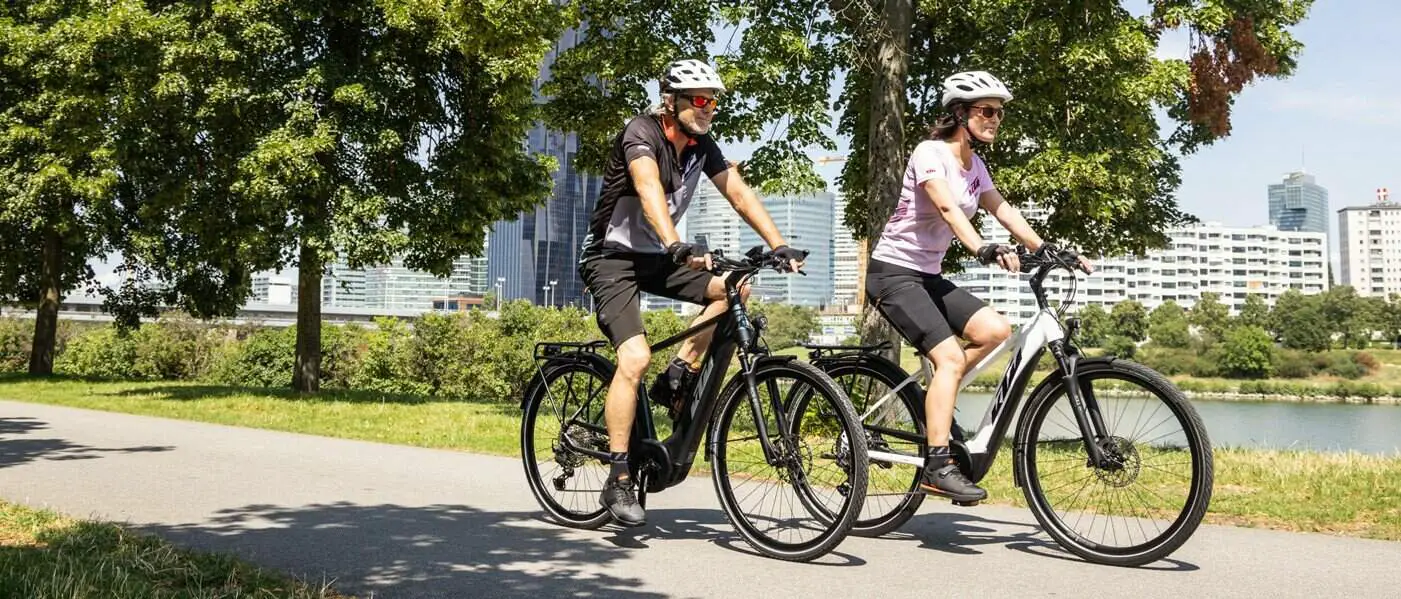Last Updated on October 2, 2023 by Igor Karni

There are many benefits to riding an e-bike, but what exactly are the ways in which e-bikes can be used for exercise purposes?
This article addresses any questions you may have about exercising on an e-bike. Questions like what type of muscles are working, how your body will benefit, what type of fitness e-biking provides, and how it compares to other forms of exercise will be answered. Read on to find out!
E-Biking for cardio exercise
Cardio, also known as aerobic, exercise is any kind of exercise ranging between low and high intensity which raises your heart rate. The benefits of partaking in consistent cardio exercise are improved lung capacity, reduced stress, regulated circulation, decreased resting heart rate, improved metabolism, and reduced blood pressure.
Increased metabolism means that you will more easily be able to burn fat and lose weight, and most importantly, cardio exercise keeps our hearts strong and functioning.
Cycling is one of the most common and reliable forms of cardio exercise. Though a common concern is one that compares e-biking’s effectiveness compared to traditional bicycling, research shows that e-Biking is just as effective as traditional cycling.
Read also: Can I use e-bike to get fit or for weight loss? And, Are e-bikes good for cardio exercise?
Typically, a rider loses anywhere between 300-400 calories on an e-Bike, whereas on a traditional bike it’s around 400-500 calories per hour. Riders can also adjust their workout’s intensity by altering assistance levels on their e-Bikes.
Some of the benefits of e-biking over traditional cycling are:
- Getting around faster
- Covering larger distances
- Providing a less sweaty way to commute to work
Various studies have also shown that cyclists tend to use their e-Bike more frequently than their traditional bike, which means that they are getting more consistent cardio workouts.

E-Biking is also an active mode of transportation, allowing those who are otherwise mostly sedentary to incorporate aerobic exercise into their lives. The results of cardio exercise include reduced risk of heart disease, high cholesterol, diabetes, obesity, and even some types of cancer.
To optimize your cardio exercise on the e-Bike, riders should try to ride somewhere between 3-5 days a week for 30-60 minutes at a time (source).
E-Biking for strength and endurance training
Strength training and endurance training focus on strengthening different functions of the body, both of which are equally beneficial to overall health. Endurance training is also known as cardio or aerobic exercise, whereas strength training is anaerobic.
E-Biking can be beneficial for both types of training.
Endurance training helps to build heart and lung strength, as well as benefiting overall fitness (typically associated with “toning” the body). To accomplish this type of training on an e-Bike, riders can either do low-intensity rides for a long and steady pace, or high-intensity workouts coupled with interval training.
High-intensity interval training (HIIT) has been proven to be more effective when it comes to improving endurance and fat-burning capabilities. HIIT is done by alternating your pace between intense effort and a lighter “recovery” period during your exercise session.
Read also: Does riding an e-bike help lose belly fat? And, Does riding an electric bike help train strength and endurance?
Intense efforts and recovery periods can range from being the same length of time – e.g. 2 minutes of intense and 2 minutes of recovery – but it completely depends on what you are comfortable with. For example, you can do 30 seconds of intense training and 1 minute of recovery, or 10 minutes of intense and 5 minutes of recovery. The recommended number of sets usually ranges between 2-5, but again, you can customize this accordingly.
For strength training, one strengthens muscles by using resistance that the muscles need to use force against. This is typically associated with using weights and weight-bearing machinery (for example using deadlifts, kettlebells, and free weights).
E-Biking is not a weight-bearing activity, but riders can make use of the gear resistance for strength training, which will particularly benefit the leg muscles (hamstrings, calves, quads, and feet) and parts of the upper body (shoulders, biceps, triceps, and core).
The benefits of strength training are increased bone, muscle, tendon, and ligament strength, as well as improved joint and cardiac function and increased metabolism.
Strength training on an e-Bike can be done by upping the gear resistance so as to ensure that your muscles are working harder to cycle. Strength training can also be done by riding uphill, standing while biking (only if you are comfortable with this), and tightening your core while you ride.

Using e-cycling to help reduce belly fat
Getting a flat stomach tends to be a commonly shared goal amongst us all. Before you tackle your belly fat, it’s important to bear in mind that there are two types of fat: visceral and subcutaneous (source).
So, how does e-Cycling help with losing belly fat?
First, as mentioned earlier in the article, cycling is an effective aerobic/cardio exercise, and aerobic exercise improves one’s metabolism (the body’s process of making and using energy). This means that when doing consistent aerobic exercise, the body is better able to burn calories and belly fat, particularly visceral fat.
Doing an exercise regime that couples both high-intensity interval training and low-intensity rides tends to have the best results when it comes to burning fat, so consider doing a routine that incorporates both types of rides.
Read also: Would riding an e-bike help me lose belly fat? And, Which muscles work when riding an electric bicycle?
In addition to this, HIIT is one of the leading methods of exercise routines that have shown to be more effective for reducing belly fat than doing only moderate or lower intensity exercise. The best part is that HIIT should only be done once or twice a week, which is all you need in order to benefit your body.
High-intensity interval training also helps to release your human growth hormone, which helps you to burn fat and maintain muscle more effectively. This hormone also regulates your appetite which makes it less likely for you to overeat or binge eat, which will help you achieve and maintain a toned body.
Which muscles work when e-Biking?
When you ride your e-Bike, there are many muscles within your whole body that are engaged. While these different muscles are engaged to varying extents, your entire body benefits nonetheless.

Your legs are the part of your body that are benefitted the most when you ride your e-Bike. This is because your legs provide the main power source for pedaling when you ride. E-Cycling engages your thighs, which include your hamstring and quadricep muscles, and calves, specifically the gastrocnemius and soleus muscles.
Your hamstrings, which run down the back of your thighs from the pelvis to the knees, allow your knees to bend – which is essential for the pedaling action you must take while riding. Your quadriceps are located along the front of your thighs (source), so the more you pedal and faster you go, the more of a workout you’ll get in your quads. In your calves, the gastrocnemius and soleus muscles are located on the back of your legs are heavily worked while you pedal on your e-Bike. These muscles are essential to helping you keep your balance.
As well, your gluteal (buttocks) muscles play a big role in e-Biking and are heavily benefitted. These muscles are essential to help you complete the cycling motion, and e-biking targets the glutes since they help to control your hips and legs, and in turn your pedaling.
Read also: Which muscles work when riding an electric bike? And, How does riding an e-bike change your body shape?
While the arms are typically less targeted than your legs and glutes, your upper arm muscles, or biceps and triceps, are still activated when you ride. Your shoulders also benefit, particularly your deltoid muscles.
The reason these muscles are targeted is that your arms are essential to supporting and balancing your upper body while you ride, which is accomplished by steering. Your core, or abdominal and upper body muscles, are also strengthened by e-Biking.
How does e-Biking change my body?
E-Biking has the capabilities to change one’s body shape, depending on various factors.
In order to better understand this, it’s important to recognize the biological differences between genders and natural body shapes, the consistency in which you ride, the type of training you do on your e-Bike, and other factors.
The first thing is to understand the natural physiological differences between male and female bodies. For example, women usually have less testosterone and a higher percentage of body fat than men. Since testosterone is the hormone that helps to build bigger muscles, men can generally build muscle more easily.
Next, there is the factor of natural body shapes and understanding which body type you most fit into. There are three main categories of natural body types that humans fall under, and these categories are Endomorphs, Ectomorphs, and Mesomorphs.
Endomorphs generally have larger frames due to a higher percentage of body fat and less muscle mass. Because of these two factors, Endomorphs typically are more easily affected by caloric intake than other body types. For example, their weight fluctuates more easily, which is impacted by diet.

Ectomorphs are on the opposite spectrum, and usually have smaller frames and little body fat. Ectomorphs tend to be longer and leaner in the frame, but the commonality between them and Endomorphs is having less muscle mass. People with this body type tend to have a harder time gaining weight and muscle and are not easily affected by caloric intake.
Finally, the last of the categories are Mesomorphs. These types of people straddle the line between the two others and typically have medium-sized frames. Mesomorphs can also develop muscles more easily and tend to have more muscle, rather than fat, on their bodies.
Read also: Which muscles work when riding an electric bike? And, How does riding an e-bike change your body shape?
Due to these differing factors, Ectomorphs usually excel at cardio and endurance-focused exercises, and Endomorphs and Mesomorphs usually excel at strength and power-focused exercises.
This means that e-Biking, being a cardio-focused sport, is a great resource for Endomorphs and Mesomorphs, who tend to need to target losing body weight. Ectomorphs should use e-Biking for strength training (the methods of which are mentioned earlier in the article) if they are looking to gain muscle.
Is e-Biking cheating?
There is, unfortunately, a large presence of rhetoric that claims e-Biking to be, on some level, “cheating”. The source of this so-called cheating is usually blamed on the electric assistance, which assumes that the battery and motor make it so the rider isn’t exerting physically beneficial effort when compared to traditional cycling. However, this claim has been disproved repeatedly, and, in fact, has shown the opposite.
First off, traditional bicycling is not a feasible option for everyone, particularly those who have serious physical conditions. People dealing with joint-related conditions, heart-related illness, diabetes, older age, and many other ailments find it extremely exhausting and difficult – if not impossible – to rely on traditional cycling as a consistent method of exercise since it requires 100% human power.
Read also: Are electric bikes cheating (backed by research)? And, Are electric bikes good for fitness?
Thus, the presence of electric assistance enables e-Biking to be much more accessible for riders dealing with all types of health issues. In turn, this allows e-Bikes to be relied on for commuting, leisure, and regular exercise.
Second, as shown by the evidence in the former part of this article, e-biking helps to improve fitness levels, blood pressure, metabolism, and much more. Not only that, but many e-Bike riders have noted that this form of exercise has helped them to improve their overall fitness and even helped to manage their physical and mental conditions.
Furthermore, the benefits of e-biking have been demonstrated by scientific evidence. For example, a 2017 study done in Norway (source) showed that e-Bike riders were physically active for 95% of their riding time, which was the same amount shown in traditional cycling.

Another study from the University of Basel (source) determined that e-Bikes’ ability to improve cardiorespiratory fitness was similar to traditional bicycling, even with electric assistance, predominantly due to the fact that e-biking enables higher biking speeds.
Lastly, e-Biking has also been proven to be better suited for frequency, as riders of traditional bikes and e-Bikes alike have noted that the accessibility of e-Bikes makes for heightened reliability. This, in turn, means that riders are getting more regular exercise with their e-Bikes, ensuring a more consistent fitness regime.
How does e-Biking compare to walking?
Walking is an exercise that many people turn to because it’s so easy to incorporate into daily life, and has many benefits. So how does it compare to e-Biking?
On a calorie-burning level, riding an e-Bike can burn anywhere between 280 – 450 calories per hour. Comparatively, this equals out to the same number as brisk walking or light jogging.
Of course, this all depends on the type of walking you are doing. While a slower stroll will burn fewer calories, a power walk will burn more. Similarly, with e-Biking, if riders are going for longer rides with less pedal-assist they will burn more calories, whereas a shorter ride with more-pedal assist will burn less.
The benefits of walking include increased cardiovascular fitness, reduced risk of heart disease and stroke, and improved management of high blood pressure, high cholesterol, and diabetes.
Read also: How does riding an e-bike compare to walking? And, How does riding an e-bike compare to running?
Walking can also improve bone density as well as improve one’s balance. Since e-Biking is an aerobic-focused sport (the benefits of which are also mentioned previously in the article), e-biking benefits in all the same ways.
One of the benefits of e-biking over walking is that it will cover more ground, as well as make it easier to brave harsher terrain such as hills or uneven roads. E-Biking also typically has a lower impact on the body, as walking on pavement can be quite harsh on the knees, hips, and feet, especially when done for extended periods of time. Thus, e-Biking is less strenuous on one’s body.
The great thing about e-Bikes, as well, is the customizability based on how you’re feeling on the day you are riding. For example, if you are feeling more tired on a certain day, you can up the pedal-assist to ensure you don’t fatigue yourself, but still ensure that you are getting your exercise in. This is much harder to do with walking since it solely requires human power, and thus is less customizable on days you might be feeling tired.
How does e-Biking compare to running?
Running is one of the top forms of exercise people think of when they hear “aerobic sports” and has many physical benefits. Since e-Biking is also an aerobic sport, how do the two compare?

Running is an exercise that involves jumping from foot to foot to propel oneself forward. This type of exercise is mostly done by young to middle-aged people who are generally not suffering from physical barriers. It’s an effective exercise for maintaining overall fitness and weight loss, and many do it for competitive sport in school (such as high school, university, and college).
E-biking uses electric-powered motors that give riders an extra boost when cycling but is still reliant on the human motion of pedaling in order to propel the movement. This is one of the factors that makes e-Cycling great for those who have just started their fitness regimes, or who are dealing with physical barriers (such as arthritis, heart disease, high blood pressure, weight issues, and age). E-Bikes help to prevent excess fatigue and tend to keep riders happy and fitness-motivated.
Various studies have shown that a person will burn around 400 calories per hour when running. Bear in mind this number is also dependent on the person’s body weight and other factors, which may require further distance covered to burn that number of calories.
Read also: Can I use e-bike to get fit or for weight loss? And, Are e-bikes good for cardio exercise?
In comparison, riding e-bike results in around 300 calories burnt per hour, which means that there’s only a difference of around 100 calories between the two, showing that e-biking compares quite well to running. Of course, riders can also increase their intensity in order to burn more calories per hour, too.
Another study has shown that long-distance runners have a much higher percentage of muscle damage (133% to 404%), inflammation levels (up to 256%), and muscle soreness (up to 87%) in the following 38 hours of recovery period than cyclists do.
This is likely because running is a high-impact sport (particularly on the knees, hips, feet, and ankles), and this type of impact can be tough on the immune system.
Meanwhile, e-Cycling is a low-impact sport that is optimal even for those dealing with inflammation and joint problems, enabling riders to get similar benefits of running while reducing inflammation and without risking the same level of muscle damage and soreness.
A few words in conclusion
As you can see, there are many fitness-related advantages to riding an e-bike. Whether it’s relying on e-biking for various strength and conditioning workouts to utilizing it to overcome any physical barriers you might be facing, the benefits are infinite.
E-Bikes are a reliable, safe, effective, and accessible form of exercise that allows for an endless number of exercise options!
Let us know how we are doing! Have another question or a recommendation for us? – reach us via this contact form.
Igor is a sustainable mobility and green energy advocate. His mission for Easy E-biking is to help make electric cycling simple, practical, and fun. Follow him on Facebook and LinkedIn.




